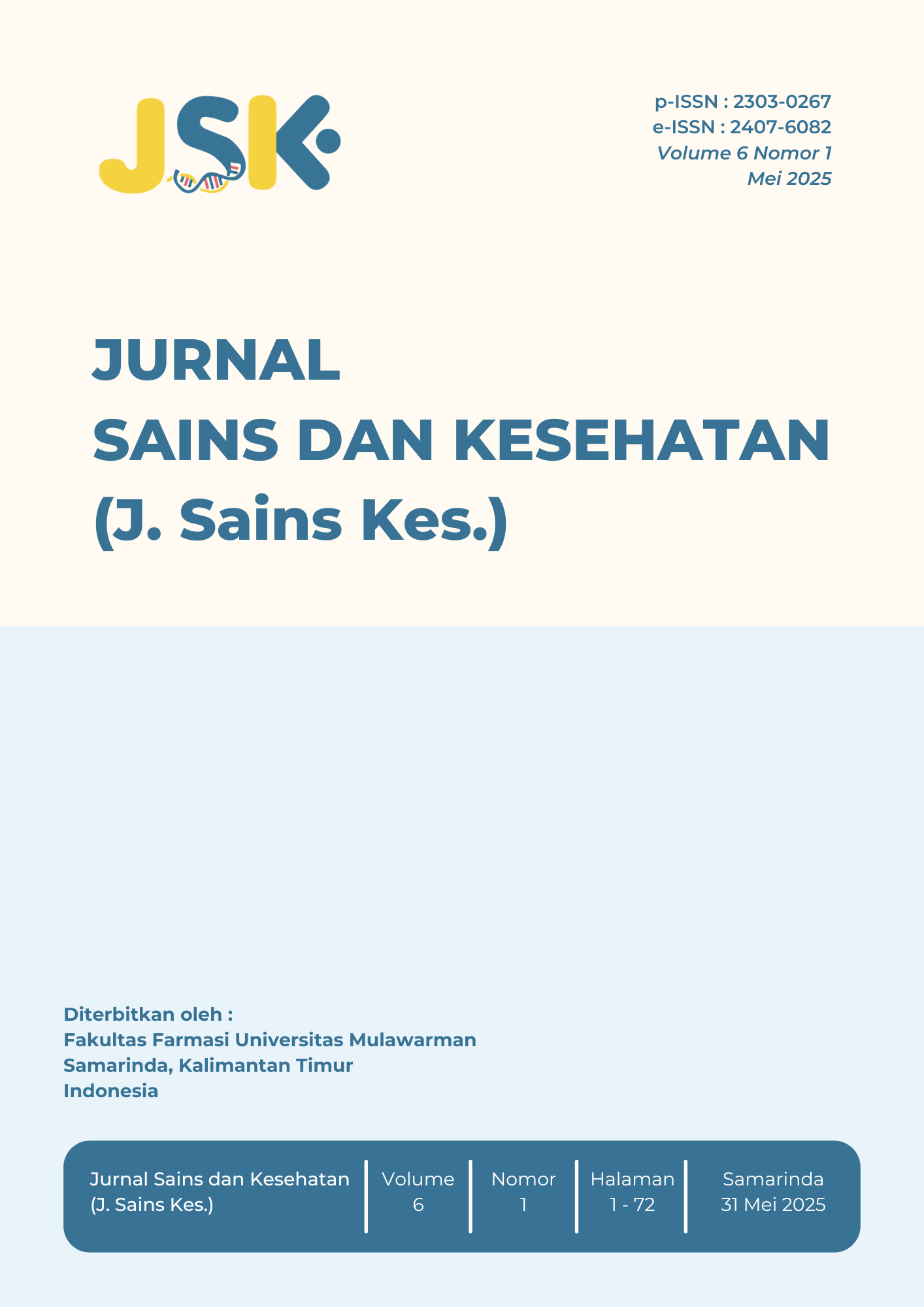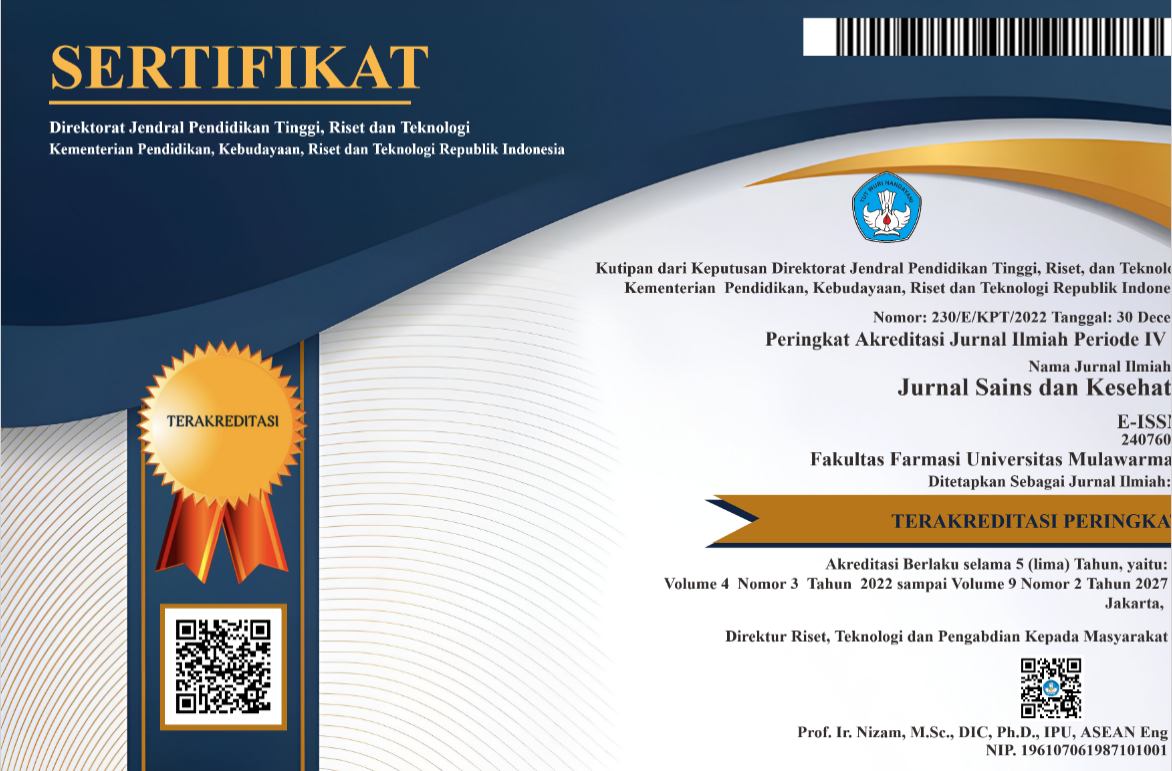Potensi Daun Bandotan (Ageratum conyzoides L.) Terhadap Biofilm Streptococcus pyogenes
Potential of Bandotan (Ageratum conyzoides L.) Leaves Against Streptococcus pyogenes ATCC 19615 Biofilm
DOI:
https://doi.org/10.30872/jsk.v6i1.653Abstract
References
[1] A. Gómez-Mejia, M. Orlietti, A. Tarnutzer, S. Mairpady Shambat, and A. S. Zinkernagel, “Inhibition of Streptococcus pyogenes biofilm by Lactiplantibacillus plantarum and Lacticaseibacillus rhamnosus.,” mSphere, vol. 9, no. 10, p. e0043024, Oct. 2024, doi: 10.1128/msphere.00430-24.
[2] P. L. Against, S. Aureus, Y. Pranata, I. Rahmawati, and O. Saptarini, “Antibacterial and Antibiofilm Activity of Papaya Leaf Fractions ( Carica,” vol. 4, no. 6, pp. 811–822, 2024.
[3] S. A. I. Maulidya, D. A. Nuari, S. Suryana, and S. Almarifah, “Antibacterial Activity of Bandotan (Ageratum Conyzoides L) Leaves Extracts Against Methicillin-Resistant Staphylococcus aureus,” Borneo J. Pharm., vol. 3, no. 4, pp. 243–248, 2020, doi: 10.33084/bjop.v3i4.1552.
[4] L. R. Marks, L. Mashburn-Warren, M. J. Federle, and A. P. Hakansson, “Streptococcus pyogenes biofilm growth in vitro and in vivo and its role in colonization, virulence, and genetic exchange.,” J. Infect. Dis., vol. 210, no. 1, pp. 25–34, Jul. 2014, doi: 10.1093/infdis/jiu058.
[5] Y. Mulyani, L. Febiani, and A. Yuniarto, “Review Artikel tanaman Bandotan (Ageratum conyzoides Linn) sebagai antibakteri, antioksidan dan antiinflamasi,” J. Farm. dan Sains Vol, vol. 5, no. 1, 2021.
[6] D. W. Kusumo et al., “Skrining Fitokimia Senyawa Metabolit Sekunder Pada Ekstrak Etanol Bunga Pepaya ( Carica papaya L .) ( Phytochemical Screening of Secondary Metabolites in Papaya Flowers / Carica papaya L .),” vol. 5, no. 2, 2022.
[7] T. Zulfikar, A. Sutriana, and A. Rozaliyana, “Phytochemical screening of three extraction process of Calotropis gigantea,” in IOP Conference Series: Earth and Environmental Science, IOP Publishing, 2024, p. 12082.
[8] Y. Mulyani, P. Hasimun, E. Fazila, and K. Asfa, “Antidiabetic And Antidyslipidemic Activities Of Combined Bandotan ( Ageratum Conyzoides ) And Sambung Nyawa ( Gynura Procumbens ) Ethanol Extracts In Insulin-Resistant Rat Models,” vol. 12, no. 20, pp. 1088–1103, 2023.
[9] C. Young, R. C. Holder, and L. Dubois, “Streptococcus pyogenes biofilm,” Streptococcus pyogenes Basic Biol. to Clin. Manifestations [Internet]. 2nd Ed., 2022.
[10] M. Ridwan, R. Risandiansyah, and A. Yahya, “Aktivitas Antibakteri Dan Antibiofilm Ekstrak Kelopak Bunga Rosella (Hibiscus sabdariffa) terhadap Streptococcus mutans,” J. Kedokt. Komunitas (Journal Community Med., vol. 11, no. 2, 2023.
[11] M. Bafadal, T. Hertiani, S. U. T. Pratiwi, and A. C. Narsa, “Exploring The Inhibitory Potential of Massoia Oil on Biofilm Dual-Species Culture of Staphylococcus aureus and Pseudomonas aeruginosa,” Egypt. J. Chem., vol. 66, no. 8, pp. 185–190, 2023, doi: 10.21608/ejchem.2022.169290.7100.
[12] F. Alamiri, O. André, S. De, P. Nordenfelt, and A. P. Hakansson, “Role of serotype and virulence determinants of Streptococcus pyogenes biofilm bacteria in internalization and persistence in epithelial cells in vitro.,” Front. Cell. Infect. Microbiol., vol. 13, p. 1146431, 2023, doi: 10.3389/fcimb.2023.1146431.
[13] D. Lorenzo, “Chloramphenicol Resurrected: A Journey from Antibiotic Resistance in Eye Infections to Biofilm and Ocular Microbiota.,” Microorganisms, vol. 7, no. 9, Aug. 2019, doi: 10.3390/microorganisms7090278.
[14] H. Aisyah Suci Mahdiva, Febriani, “Aktivitas Antibakteri Getah Jarak Pagar (Jatropha curcas L.) Terhadap Bakteri Staphylococcus epidermidis” vol. 4, no. 2, pp. 109–114, 2021.
[15] V. Puca, B. Marinacci, B. Pellegrini, F. Campanile, M. Santagati, and R. Grande, “Biofilm and bacterial membrane vesicles: recent advances.,” Expert Opin. Ther. Pat., vol. 34, no. 6, pp. 475–491, Jun. 2024, doi: 10.1080/13543776.2024.2338101.
[16] C. Alves-Barroco, J. Paquete-Ferreira, T. Santos-Silva, and A. R. Fernandes, “Singularities of Pyogenic Streptococcal Biofilms - From Formation to Health Implication.,” Front. Microbiol., vol. 11, p. 584947, 2020, doi: 10.3389/fmicb.2020.584947.
[17] N. M. Wijesundara and H. P. V. Rupasinghe, “Bactericidal and Anti-Biofilm Activity of Ethanol Extracts Derived from Selected Medicinal Plants against Streptococcus pyogenes.,” Molecules, vol. 24, no. 6, Mar. 2019, doi: 10.3390/molecules24061165.
[18] E. J. Besan, I. Rahmawati, and O. Saptarini, “PHARMACY : Jurnal Farmasi Indonesia (Pharmaceutical Journal of Indonesia) Aktivitas Antibiofilm Ekstrak dan Fraksi-Fraksi Bunga Telang (Clitoria ternatea L.) terhadap Staphylococcus aureus Antibiofilm Activity of Butterfly Pea Flower ( Clitoria ternat,” vol. 20, no. 01, pp. 1–11, 2023.
[19] Z. Ayad et al., “Current Clinical and Medical Education,” vol. 2, no. May, 2024.
[20] M. Zahki, “Efektifitas Antibakteri Senyawa Metabolit Sekunder Pada Beberapa Tanaman Obat Terhadap Pertumbuhan Bakteri Staphylococcus aureus,” Usadha, vol. 2, no. 2, pp. 25–30, 2023.
Downloads
Published
Issue
Section
License
Copyright (c) 2025 Jurnal Sains dan Kesehatan

This work is licensed under a Creative Commons Attribution-NonCommercial 4.0 International License.
How to Cite
Most read articles by the same author(s)
- Fajar Presetya, Mentarry Bafadal, Nurul Muhlisa, Fikri Ramdhani Sahar, Onny Ziasti Fricillia, Pryenalvend Khisanta Piter, Gayuk Kalih Prasesti, Evaluasi Farmakologis dan Toksikologis Ekstrak Etanol Daun Kratom (Mitragyna speciosa) sebagai Kandidat Analgesik Selektif COX-2 dengan Aktivitas Stimulan Sistem Saraf Pusat dan Profil Keamanan Akut pada Mencit , Jurnal Sains dan Kesehatan: Vol. 6 No. 2 (2025)




